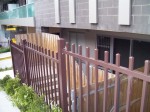Subterranean Apartments
We have a collection of photos below showing how developers are increasing apartment density by sinking apartments underground!
The photos below are of an apartment complex corner of Berkley and Tower Streets in Doncaster adjacent to the Westfield Shopping Centre.
Sunken living areas have been a measure employed to conceal the true height of a building to create a higher apartment yield.
There are several old permits, similarly configured but not activated, in both the DDO8 and the Doncaster Hill Strategies.
The C96 panel, in regard to the DDO8, recommended it “be modified to include a design objective to limit below ground light courts so that living spaces have suitable access to natural light” but were not definitive on what guidelines should be applied.
We have previously highlighted the poor design of this practice, in the 2-6 Thiele St Apartments, ( see key issues section) and Foote St.
In Sydney Ten-storeys to be built underground to allow apartment residents more space
These local apartments are below natural ground level, but not as bad as in some cities… Rising home prices send China’s ‘Rat Race’ scurrying underground







8 Comments
We know the development shown in the pictures very well, we walk past it every day and it is an eyesore. How could Manningham Council approve these underground apartments? Why was this particular developer allowed to circumvent Manningham’s own ingrained principles of good and proper planning? The occupants have no outlook or access to sunlight unless they climb up on to the street! You read all the literature about how well Doncaster Hill is to be planned, in their own manual it reads;
6.4. To provide greater residential amenity through well designed private open space. Shared private open space should be designed to create a pleasant and useable outdoor or indoor living spaces through consideration of factors including wind, solar access and landscape treatment; and enhance the safety and security of residents with consideration of the residential amenity including acoustic and visual privacy of neighbours.
Provide living areas and private open space to maximise solar access. External spaces should be directly linked to commercial or other people-intensive activity, provide shelter and capitalise on views and solar access.
Westfield Worker
This is the result of council approving the location of apartments in car park basements to allow developers to increase the number of apartments. In this case we have 7 apartments on the same level as the underground car park including 4 dwellings which are completely below the foot path level in Tower Street.
There has always been pressure from traders for council to get apartment developments up and running on Doncaster Hill. It was no surprise when Westfield, the catalyst and driver of the high rise strategy, had delayed commencement of their extension for several years .Even today, after almost 12 years, council have only delivered less than 12% of the planned customer catchment of 4,080 apartment residents on Westfield’s doorstep.
Council Street
I would never ever again live in a basement apartment where light is restricted. Once we moved out I felt so different waking up to sunlight and having a view. I think basements should be reserved for car parking and storage.
Midge
This type of apartment originated in London and was very common during the Victorian era in densely populated urban areas. They can be found in New York, Moscow and other cities where living space was at a premium. They have generally been regarded as substandard living accommodations for families but have proven a cheap rental option for young single professionals.
Arthur
Tower Street is one of several developments approved with its dwellings cut deeply below the natural ground level.
The proposed apartment development at 97 Whittens Lane is another where maximum apartment yield is to be achieved by sinking living areas well below the NGL where daylight and ventilation will be received by the use of light courts.
On sloping sites, whilst it should be avoided, it is often necessary to partially excavate in order to provide sufficient depth to allow the building to marry the ground in a natural fashion. In the case of Whittens Lane, the wholesale excavation of the site will deny the natural land form and result in a very poor relationship with the boundaries of the land. The depth of the site excavation could have been substantially reduced if Council’s additional 1 metre height allowance, applicable on sloped sites, a measure to help raise the building and minimise the need of earthworks, had been correctly utilised.
Objector
Living in an apartment full of light and living in one without are really two entirely different things–like the difference between living in a cave or living in a treetop.
My boyfriend and I lived in an apartment in Brooklyn USA for nearly two years. It was cheap, but we slowly grew to hate it. Although we had two windows facing the street they didn’t let in much light because we were completely below the level of the pavement, and everyone walking on the street could see down into our bedroom and lounge when the blinds were open.
Renting
Among the reasons for our objection to the development at 97 Whittens lane was against council’s approval of the underground apartments. Below is an excerpt from the Council report supporting the concept;
“The high dwelling yield is achieved in part by sinking the Ground Floor into the ground and relying on an atypical provision of light wells and sunken courtyards. While this is the first apartment design in Manningham to propose this arrangement, this is no reason to oppose it”.
The latter part of the above statement was not true because Manningham Council had already approved several developments with underground dwellings, such as the development shown in the photos, some three years earlier.
Foster
Allowing full or semi-sunken dwellings, by means of excessive excavation, is desperate planning but a very cost effective means of increasing the density of apartment developments. Despite the reduction of occupant amenity levels, it allows the developer to circumvent the planning authority’s building height restriction, generally measured from above the natural ground level, so that the number of apartments located below becomes a huge bonus for the developer.
It surprises me that Council are permitting this type of housing in the Doncaster Hill and DDO8 strategies, once hailed as the latest sought-out futuristic plans of the 21st century with developers expected to flock to it. The reality is that they are, despite expensive promotion, flagging. We have a host of old speculative planning permits, yet to be activated, but no cranes on the horizon.
Nick